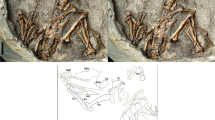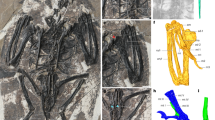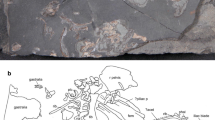Abstract
Spalacotheroid “symmetrodontans” are a group of extinct Mesozoic mammals. They are basal taxa in the trechnotherian clade that includes modern marsupials and placentals. Therefore, fossils of spalacotheroids can provide information on the ancestral condition from which marsupials and placentals likely have evolved. Here, we describe the postcranial skeleton of Akidolestes cifellii, a spalacotheroid species from the Lower Cretaceous Yixian Formation of northeastern China. Our comparison of the skeletal features of Akidolestes and the closely related Zhangheotherium and Maotherium indicates some major morphological and functional differences in the postcranium among these spalacotheroid mammals. Akidolestes shows characters for terrestrial habitat preference. Overall it appears to be a generalized terrestrial mammal. Akidolestes differs from Zhangheotherium and Maotherium in some characteristics of the scapula, the pelvis, and the hind limb, some of which can be directly correlated with different locomotor capabilities, and possibly also habitat preferences. This suggests that a greater ecomorphological differentiation occurred in these stem therian mammals than previously thought and that ecological differentiation is a major pattern in early therian mammal evolution.




















Similar content being viewed by others
References
Argot C (2001) Functional-adaptive anatomy of the forelimb in the Didelphidae, and the paleobiology of the Paleocene marsupials Mayulestes ferox and Pucadelphys andinus. J Morphol 247:51–79
Argot C (2002) Functional-adaptive analysis of the hindlimb anatomy of extant marsupials and the paleobiology of the Paleocene marsupials Mayulestes ferox and Pucadelphys andinus. J Morphol 253:76–108
Argot C (2003) Functional-adaptive anatomy of the axial skeleton of some extant marsupials and the paleobiology of the Paleocene marsupials Mayulestes ferox and Pucadelphys andinus. J Morphol 255:279–300
Averianov AO (2002) Early Cretaceous “symmetrodont” mammal Gobiotheriodon from Mongolia and the classification of “Symmetrodonta.” Acta Palaeontol Pol 47: 705–716
Averianov AO, Lopatin AV (2008) “Protocone” in a pretribosphenic and upper dentition of tinodontid “symmetrodontans.” J Vertebr Paleontol 28:548–552
Beard KC (1993) Origin and evolution of gliding in early Cenozoic Dermoptera (Mammalia, Primatomorpha). In: MacPhee RDE (ed) Primates and Their Relatives in Phylogenetic Perspective. Plenum Press, New York, pp 63–90
Bloch JI, Boyer DM (2002) Grasping primate origins. Science 298:1606–1610
Cartmill M (1985) Climbing. In: Hildebrand M, Bramble DM, Liem KF, Wake DB (eds) Functional Vertebrate Morphology. Harvard University of Press, Cambridge, pp 73–88
Cassiliano ML, Clemens WA (1979) Symmetrodonta. In: Lillegraven JA, Kielan-Jaworowska Z, Clemens WA (eds) Mesozoic Mammals: The First Two-thirds of Mammalian History. University California Press, Berkeley, pp 150–161
Cave AJE (1970) Observation on the monotreme interclavicle. J Zool Lond 160:297–312
Chen M, Luo Z-X (2008) Morphology of dentition and postcranial skeleton of Akidolestes. Acta Geol Sin 82:155–164 (in Chinese with English abstract)
Chester SGB, Sargis EJ, Szalay FS, Archibald JD, Averianov, AO (2010) Mammalian distal humeri from the Late Cretaceous of Uzbekistan. Acta Palaeontol Pol 55: 199–211
Cifelli RL, Madsen SK (1986) An Upper Cretaceous symmetrodont (Mammalia) from southern Utah. J Vertebr Paleontol 6:258–263
Cifelli RL, Madsen SK (1999) Spalacotheriid symmetrodonts (Mammalia) from the medial Cretaceous (upper Albian or lower Cenomanian) Mussentuchit local fauna, Cedar Mountain Formation, Utah, USA. Geodiversitas 21:167–214
Clemens WA (1963) Late Jurassic mammalian fossils in the Sedgwick Museum, Cambridge. Palaeontology 6:373–377
Crompton AW (1971) The origin of the tribosphenic molar. In: Kermack DM, Kermack KA (eds) Early Mammals. Zool J Linn Soc 50 (supp 1), pp 65–87
Crompton AW, Jenkins FA Jr (1967) Ammerican Jurassic symmetrodonts and Rhaetic “pantotheres.” Science 155:1006–1009
Ensom P, Sigogneau-Russell D (2000) New symmetrodonts (Mammalia, Theria) from the Purbeck Limestone Group, Lower Cretaceous, southern England. Cretaceous Res 21:767–779
Evans HE (1993) Miller’s Anatomy of the Dog, 3rd edn. W.B. Saunders Company, Philadelphia
Filler AG (1986) Axial character seriation in mammals: an historical and morphological exploration of the origin, development, use and current collapse of the homology paradigm. Dissertation, Harvard University
Fox RC (1976) Additions to the mammalian local fauna from the upper Milk River Formation (Upper Cretaceous), Alberta. Can J Earth Sci 13:1105–1118
Gambaryan PP, Aristov, AA, Dixon JM, and Zubtsova GY (2002) Peculiarities of the hind limb musculature in monotremes: an anatomical description and functional approach. Russ J Theriol 1:1–36
Gambaryan PP, Kielan-Jaworowska Z (1997) Sprawling versus parasagittal stance of multituberculate mammals. Acta Palaeontol Pol 42:13–44
Gao C-L, Wilson GP, Luo Z-X, Maga AM, Meng Q-J, Wang X-R (2009) A new mammal skull from the Lower Cretaceous of China with implications for the evolution of obtuse-angled molars and ‘amphilestid’ entriconodonts. Proc R Soc B 277:237–246
Gill P (2004) A new symmetrodont from the Early Cretaceous of England. J Vertebr Paleontol 24:748–752
Grant T (1995) The Platypus–A Unique Mammal. University of New South Wales Press, Sydney
Horovitz I (2000) The tarsus of Ukhaatherium nessovi (Eutheria, Mammalia) from the Late Cretaceous of Mongolia: an appraisal of the evolution of the ankle in basal therians. J Vertebr Paleontol 20:547–560
Hu Y-M (2006) Postcranial morphology of Repenomamus (Eutriconodonta, Mammalia): implications for the higher-level phylogeny of mammals. Dissertation, The City University of New York
Hu Y-M, Wang YQ (2002) Sinobataar gen. nov.: first multituberculate from Jehol Biota of Liaoning, northern China. Chin Sci Bull 47:933–938
Hu Y-M, Meng J, Wang Y-Q, Li C-K (2005b) Large Mesozoic mammals fed on young dinosaurs. Nature 433:149–152
Hu Y-M, Wang Y-Q, Luo Z-X, Li C-K (1997) A new symmetrodont mammal from China and its implications for mammalian evolution. Nature 390:137–142
Hu Y-M, Wang Y-Q, Luo Z-X, Li C-K (1998) Morphology of dentition and forelimb of Zhangheotherium. Vertebr PalAsia 36:102–125 (in Chinese with English translation)
Hu Y-M, Wang Y-Q, Fox RC, Li C-K (2005a) A new spalacotheriid symmetrodont from the Early Cretaceous of northeastern China. Am Mus Novitates 3475:1–20
Hurum JH, Luo Z-X, Kielan-Jaworowska Z (2006) Were mammals originally venomous? Acta Palaeontol Pol 51:1–11
Jenkins FA Jr (1971a). The postcranial skeleton of African cynodonts. Peabody Mus Nat Hist Bull 36:1–216
Jenkins FA Jr (1971b) Limb posture and locomotion in the Virginia opossum (Didelphis marsupialis) and in other non-cursorial mammals. J Zool Lond 165:303–315
Jenkins FA Jr (1973) The functional anatomy and evolution of the mammalian humero-ulnar joint. Am J Anat 137: 281–296.
Jenkins FA Jr (1974) Tree shrew locomotion and the origins of primate arborealism. In: Jenkins FA Jr (ed) Primate Locomotion. Academic Press, New York, pp 85–115
Jenkins FA Jr, Parrington FR (1976) The postcranial skeleton of the Triassic mammals Eozostrodon, Megazostrodon and Erythrotherium. Phil Trans R Soc Lond Ser B Biol Sci 273:387–431
Jenkins, FA Jr, Weijs WA (1979) The functional anatomy of the shoulder in the Virginia opossum (Didelphis virginiana). J Zool Lond 188:379–410
Ji Q (2002) Discovery of a Mesozoic fossil mammal with hair and soft tissue in western Liaoning, China. Geol Bull China 21:29–34 (in Chinese with English abstract)
Ji Q, Luo Z-X, Ji S-A (1999) A Chinese triconodont mammal and mosaic evolution of the mammalian skeleton. Nature 398:326–330
Ji Q, Luo Z-X, Yuan C-X, Tabrum AR (2006) A swimming mammaliaform from the Middle Jurassic and ecomorphological diversification of early mammals. Science 331:1123–1127
Ji Q, Luo Z-X, Yuan C-X, Wible JR, Zhang J-P, Georgi JA (2002) The earliest known eutherian mammal. Nature 416:816–822
Ji Q, Luo Z-X, Zhang Z-L, Yuan C-X, Xu L (2009) Evolutionary development of the middle ear in Mesozoic therian mammals. Science 326:278–231
Kelt DA, Meyer MD (2009) Body size frequency distributions in African mammals are bimodal at all spatial scales. Global Ecol Biogeogr 18: 19–29
Kermack DM, Kermack KA, Mussett F (1968) The Welsh pantothere Kuehneotherium praecursoris. J Linn Society (Zool) 47:407–423
Kielan-Jaworowaka Z (1978) Evolution of therian mammals in the Late Cretaceous of Asia. Part III. Postcranial skeleton in Zalambdalestidae. Acta Palaeontol Pol 38:5–41
Kielan-Jaworowska Z, Cifelli RL, Luo Z-X (2004) Mammals from the Age of Dinosaurs. Columbia University Press, New York
Kielan-Jaworowska Z, Gambaryan PP (1994) Postcranial anatomy and habits of Asian multituberculate mammals. Fossils and Strata 36:1–92
Kielan-Jaworowska Z, Hurum JH (2006) Limb posture in early mammals: sprawling or parasagittal. Acta Palaeontol Pol 51:393–406
Kielan-Jaworowska Z, Qi T (1990) Fossorial adaptations of a taeniolabidoid multituberculate mammal from the Eocene of China. Vertebr PalAsiatica 28:81–94
Kingdon J (1997) The Kingdon Field Guide to African Mammals. Academic Press, San Diego
Kirk EC, Lemelin P, Hamrick MW, Boyer DM, Bloch JI (2008) Intrinsic hand proportions of euarchontans and other mammals: implications for the locomotor behavior of plesiadapiforms. J Hum Evol 55:278–299
Klima M (1973) Die Frühentwicklung des Schültergürtels und des Brustbeins bei den Monotremen (Mammalia: Prototheria). Adv Anat Embryol Cell Biol 47:1–80
Klima M (1987) Early development of the shoulder girdle and sternum in marsupials (Mammalia: Metatheria). Adv Anat Embryol Cell Biol 109:1–91
Krause DW, Jenkins FA Jr (1983) The postcranial skeleton of North American multituberculates. Bull Mus Comp Zool 150:199–246
Krebs B (1991) Das skelett von Henkelotherium guimarotae gen. et sp. nov. (Eupantotheria, Mammalia) aus dem Oberen Jura von Protugal. Berlin Geowissenschaftl Abhandl A 133:1–110
Kühne WG (1956) The Liassic Therapsid Oligokyphus. British Museum (Natural History), London
Lemelin P (1999) Morphological correlates of substrate use in didelphid marsupials: implications for primate origins. J Zool Lond 247:165–175
Lessertisseur J, Saban R (1967a) Squelette axial. In: Grassé P-P (ed) Traité de Zoologie. Tome XVI (Fascicule I). Mammifères: Téguments et Squelette. Masson, Paris, pp 587–675
Lessertisseur J, Saban R (1967b) Squelette appendiculaire. In: Grassé P-P (ed) Traité de Zoologie. Tome XVI (Fascicule I). Mammifères: Téguments et Squelette. Masson, Paris, pp 709–1078
Li G, Luo Z-X (2006) A Cretaceous symmetrodont therian with some monotreme-like postcranial features. Nature 439:195–199
Lopatin AV, Maschenko EN, Averianov AO, Rezvyi AS, Skutschas PP, Leshchinskiy SV (2005) Early Cretaceous mammals from western Siberia: 1. Tinodontidae. Paleontol J 39:523–534
Luo Z-X (2007a) Transformation and diversification in the early mammalian evolution. Nature 450:1011–1019
Luo Z-X (2007b) Successive diversifications in early mammalian evolution. In: Anderson JS, Sues H-D (eds) Major Transitions in Vertebrate Evolution. Indiana University Press, Bloomington and Indianapolis, pp 337–391
Luo Z-X, Chen P-J, Li G, Chen M (2007a) A new eutriconodont mammal and evolutionary development in early mammals. Nature 446:288–293
Luo Z-X, Cifelli RL, Kielan-Jaworowska Z (2001) Dual origin of tribosphenic mammals. Nature 409:53–57
Luo Z-X, Ji Q (2005) New study on dental and skeletal features of the Cretaceous mammal Zhangheotherium. J Mammal Evol 12:337–357
Luo Z-X, Ji Q, Wible JR, Yuan C-X (2003) An Early Cretaceous tribosphenic mammal and metatherian evolution. Science 302:1934–1940
Luo Z-X, Ji Q, Yuan CX (2007b) Convergent dental evolution in pseudotribosphenic and tribosphenic mammals. Nature 450:93–97
Luo Z-X, Kielan-Jaworowska Z, Cifelli RL (2002) In quest for a phylogeny of Mesozoic mammals. Acta Palaeontol Pol 47:1–78
Luo Z-X, Wible JR (2005) A Late Jurassic digging mammal and early mammalian diversification. Science 308:103–107
Luo ZX, Yuan, CX, Meng QJ, Ji Q (2011) A Jurassic eutherian mammal and the divergence of marsupials and placentals. Nature 476:442–445
MacLeod N, Rose KD (1993) Inferring locomotor behavior in Paleogene mammals via eigenshape analysis. Am J Sci 293(A):300–355
Martin T (1999) Dryolestidae (Dryolestoidea, Mammalia) aus dem Oberen Jura von Portugal. Abhandl Senckenberg Naturforsch Gesellsch 550:1–119
Martin T (2002) New stem-line representatives of Zatheria (Mammalia) from the Late Jurassic of Portugal. J Vertebr Paleontol 22:332–348
Martin T (2005) Postcranial anatomy of Haldanodon exspectatus (Mammalia, Docodonta) from the Late Jurassic (Kimmeridgian) of Portugal and its bearing for mammalian evolution. Zool J Linn Soc 145:219–248
McKenna MC (1975) Toward a phylogenetic classification of the Mammalia. In: Luckett WP, Szalay FS (eds) Phylogeny of the Primates. Plenum Publishing Corporation, New York, pp 21–46
McKenna MC, Bell SK (1997) Classification of Mammals Above the Species Level. Columbia University Press, New York
Meng J, Hu Y-M, Wang Y-Q, Wang X-L, Li C-K (2006) A Mesozoic gliding mammal from northeastern China. Nature 444:889–893
Nakagawa M, Miguchi H, Sato S, Sakai S, Nakashizuka T (2007) Population dynamics of arboreal and terrestrial small mammals in a tropical rainforest, Sarawak, Malaysia. Raffles Bullet Zool 55: 389–395
Novacek MJ, Rougier GW, Wible JR, McKenna MC, Dashzeveg D, Horovitz I (1997) Epipubic bones in eutherian mammals from the Late Cretaceous of Mongolia. Nature 389:483–486
Patterson B (1956) Early Cretaceous mammals and the evolution of mammalian molar teeth. Fieldiana (Geol) 13:1–105
Pridmore, PA (1985) Terrestrial locomotion in monotremes (Mammalia, Monotremata). J Zool Lond (A) 205:53–73
Rougier GW (1993) Vincelestes neuquenianus Bonaparte (Mammalia, Theria), un primitivo mammifero del Cretacico Inferior de la Cuenca Neuqina. Dissertation, Universidad Nacional de Buenos Aires
Rougier GW, Ji Q, Novacek MJ (2003b) A new symmetrodont mammal with fur impressions from the Mesozoic of China. Acta Geol Sin 77:7–14
Rougier GW, Spurlin BK, Kik P (2003a) A new specimen of Eurylambda aequicrurius and considerations of “symmetrodont” dentition and relationships. Am Mus Novitates 3398:1–15
Rougier GW, Wible JR, Novacek MJ (1998) Implications of Deltatheridium specimens for early marsupial history. Nature 396:459–463
Rowe T (1988) Definition, diagnosis, and origin of Mammalia. J Vertebr Paleontol 8:241–264
Salton JA, Sargis EJ (2008a) Evolutionary morphology of the Tenrecoidea (Mammalia) forelimb skeleton. In: Sargis EJ and Dagosto M (eds) Mammalian Evolutionary Morphology: A Tribute to Frederick S. Szalay, Springer: Dordrecht, The Netherlands, pp. 51–71
Salton JA, Sargis EJ (2008b) Evolutionary morphology of the Tenrecoidea (Mammalia) carpal complex. Biol J Linn Soc 93: 267–288
Salton JA, Sargis EJ (2009) Evolutionary morphology of the Tenrecoidea (Mammalia) hindlimb skeleton. J Morphol 270:367–387
Salton JA, Szalay FS (2004) The tarsal complex of Afro-Malagasy Tenrecoidea: a search for phylogenetically meaningful characters. J Mammal Evol 11:73–104
Sargis EJ (2001a) A preliminary qualitative analysis of the axial skeleton of tupaiids (Mammalia, Scandentia): functional morphology and phylogenetic implications. J Zool Lond 253:473–483
Sargis EJ (2001b) The grasping behaviour, locomotion and substrate use of the tree shrews Tupaia minor and T. tana (Mammalia, Scandentia). J Zool Lond 253:485–490
Sargis EJ (2002) Functional morphology of the forelimb of tupaiids (Mammalia, Scandentia) and its phylogenetic implications. J Morphol 253:10–42
Sereno PC (2006) Shoulder girdle and forelimb in a Cretaceous multituberculate: form, functional evolution, and a proposal for basal mammalian taxonomy. In: Carrano MT, Gaudin TJ, Blob RW, Wible JR (eds) Amniote Paleobiology: Perspectives on the Evolution of Mammals, Birds, and Reptiles. University of Chicago Press, Chicago, pp 315–370
Shattuck MR, Williams SA (2010) Arboreality has allowed for the evolution of increased longevity in mammals. Proc Nat Acad Sci USA 107:4635–4639
Signogneau-Russell D (1999) Réévaluation des Peramura (Mammalia, Theria) sur la base de nouveaux spécimens du Crétacé inférieur d’Angleterre et du Maroc. Geodiversitas 21:93–127
Simpson GG (1928) A Catalogue of the Mesozoic Mammalia in the Geological Department of the British Museum. Trustees of the British Museum, London
Smythe N (1986) Competition and resource partitioning in the guild of neotropical terrestrial frugivorous mammals. Ann Rev Ecol Syst 17: 169–188
Sues H-D, Jenkins FA Jr (2006) The postcranial skeleton of Kayentatherium wellesi from the Lower Jurassic Kayenta Formation of Arizona and the phylogenetic significance of postcranial features in tritylodontid cynodonts. In: Carrano MT, Blob RW, Gaudin TJ and Wible JR (eds) Amniote Paleobiology: Perspectives on the Evolution of Mammals, Birds, and Reptiles. The University of Chicago Press, Chicago, pp. 114–152
Sun A-L, Li Y-H (1985) The postcranial skeleton of Jurassic tritylodonts from Sichuan Province. Vertebr PalAsiatica 23:135–151
Sweetman SC (2008) A spalacolestine spalacotheriid (Mammalia, Trechnotheria) from the Early Cretaceous (Barremian) of southern England and its bearing on spalacotheriid evolution. Palaeontology 51:1367–1385
Szalay FS (1994) Evolutionary History of the Marsupials and an Analysis of Osteological Characters. Cambridge University Press, Cambridge
Szalay FS, Sargis EJ (2001) Model-based analysis of postcranial osteology of marsupials from the Palaeocene of Itaboraí (Brazil) and the phylogenetics and biogeography of Metatheria. Geodiversitas 23:139–302
Szalay FS, Sargis EJ (2006) Cretaceous therian tarsals and the metatherian-eutherian dichotomy. J Mammal Evol 13:172–217
Taylor ME (1974) The functional anatomy of the forelimb of some African Viverridae (Carnivora). J Morphol 143:307–336
Taylor ME (1976) The functional anatomy of the hindlimb of some African Viverridae (Carnivora). J Morphol 148:227–253
Tsubamoto T, Rougier GW, Isaji S, Manabe M, Forasiepi AM (2004) New Early Cretaceous spalacotheriid “symmetrodont” mammal from Japan. Acta Palaeontol Pol 49:329–346
Vázquez-Molinero R, Martin T, Fischer MS, Frey R (2001) Comparative anatomical investigations of the postcranial skeleton of Henkelotherium guimarotae Krebs, 1991 (Eupantotheria, Mammalia) and their implications on its locomotion. Mitteil Mus Nat Berlin, Zool Reihe 77:207–216
Weisbecker V, Warton DI (2006) Evidence at hand: diversity, functional implications and locomotor prediction in intrinsic hand proportions of diprotodontian marsupials. J Morphol 267:1469–1485
Wible JR, Rougier GW, Novacek MJ, Asher RJ (2009) The eutherian mammal Maelestes gobiensis from the Late Cretaceous of Mongolia and the phylogeny of Cretaceous Eutheria. Bull Am Mus Nat Hist 327:1–123
Acknowledgments
We thank Prof. Xiangning Yang and Dr. Yukun Shi for facilitating research in Nanjing University. We especially want to thank Prof. Peiji Chen and Prof. Gang Li in Nanjing Institute of Geology and Palaeontology, Chinese Academy of Sciences, for helping us to access this fantastic fossil. Without great help of Profs. Chen and Li, this research would never been possible. We want to thank Drs. Vera Weisbecker and E. Christopher Kirk for discussion, and Gregory P. Wilson, Lauren Berg, Mary Dawson, John Wible, and two anonymous referees for their help to improve many aspects of this manuscript. We thank Mark A. Klingler for his skeletal and posture reconstruction of Akidolestes.
Author information
Authors and Affiliations
Corresponding author
Rights and permissions
About this article
Cite this article
Chen, M., Luo, ZX. Postcranial Skeleton of the Cretaceous Mammal Akidolestes cifellii and Its Locomotor Adaptations. J Mammal Evol 20, 159–189 (2013). https://doi.org/10.1007/s10914-012-9199-9
Published:
Issue Date:
DOI: https://doi.org/10.1007/s10914-012-9199-9




